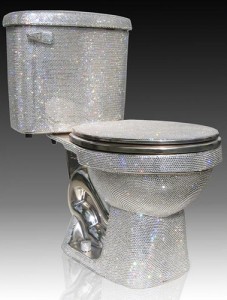A Historical Review Of The Toilet And Its Contribution To International Sanitation Efforts
Better Health –
 November 19 is International Toilet Day. That may sound funny, but it is a serious event. It is a day to contemplate what we have and others don’t. As we sit in privacy on our comfortable flush toilets today, it is hard to imagine that a scant two hundred years ago sewage disposal meant emptying chamber pots into the nearest convenient place, which was often the street.
November 19 is International Toilet Day. That may sound funny, but it is a serious event. It is a day to contemplate what we have and others don’t. As we sit in privacy on our comfortable flush toilets today, it is hard to imagine that a scant two hundred years ago sewage disposal meant emptying chamber pots into the nearest convenient place, which was often the street.
If you were out for a walk in Britain in the 18th century and heard the cry “gardy-loo,” you had better scamper across the street because the contents of a chamber pot were set to be hurled your way from a window. The expression derives from the French “regardez l’eau” and was commonly heard as chambermaids carried out their duties. Some even suggest that the custom of a gentleman walking on the outside when accompanying a lady can be traced to the desire to protect the fair sex from the trajectory of the chamber pot’s contents.
What may be even harder to imagine than the sidestepping of flying fecal matter is that roughly a third of the world’s population today cannot easily sidestep the problems associated with exposure to untreated sewage because of a lack of access to a toilet. As a consequence, diarrheal disease is rampant, killing more children than AIDS, malaria and measles combined. In developing countries a child dies every twenty seconds as a result of poor hygiene. Mahatma Gandhi recognized the problem when he proclaimed in 1925 that “sanitation is more important than independence.”
The invention of the flush toilet and the introduction of plumbing for sewage disposal mark two of the most significant advances in history. Let’s get one of the toilet myths out of the way right away. Contrary to numerous popular accounts, Thomas Crapper did not invent the flush toilet! It is easy to see how connecting his name with the invention would make for a compelling tale, but what we actually have here is a prime example of the classic journalistic foible, “a story that is too good to check.”
Almost all accounts of the Crapper saga claim that a 1969 book by Wallace Reyburn, cleverly titled “Flushed with Pride-The Story of Thomas Crapper” establishes Crapper as the inventor of the flush toilet. Reyburn actually says no such thing. The book is an entertaining celebration of the life and times of Crapper, the man who “revolutionized the nations’ water closets.” Indeed, that he did do. But flush toilets were around long before Thomas Crapper ever got into the game in the 19th century.
The first flush toilet appeared as early as 1700 B.C. The Palace of Knossos on the island of Crete, built around that time featured a toilet with an overhanging cistern that dispensed water when a plug was removed. Curiously it would take another three thousand years until the next step in flushing technology was taken by Sir John Harrington, godson of Queen Elizabeth I. In 1596 Harrington installed a “water closet” in the Royal Palace that featured a pipe fitted with a valve connected to a raised water tank. Opening the valve released the water that would carry waste into a cesspool. Apparently the Queen was not overly pleased with the invention because odours from the cesspool wafted up into the Royal powder room. It would take another couple of centuries before this problem was addressed.
The first patent for a flushing toilet designed to keep sewer gases from seeping back was issued to Alexander Cummings in 1775. Cummings designed a system that allowed some water to remain in the bowl after each flush, preventing the backflow of odours. Joseph Bramah attempted to improve upon this system with a sophisticated valve that was supposed to seal the waste pipe after each flush. While it didn’t work perfectly, Bramah’s toilet was introduced at just the right time because London was beginning to install sewage systems. Some 6000 Bramah toilets soon dotted the city’s landscape. And then about a hundred years later, along came Thomas Crapper.
In 1861 the Thomas Crapper plumbing company opened for business in London. The time was ripe for the sale of plumbing supplies because the need for proper sanitation was being firmly established. A public report issued in the city of Leeds claimed a significantly higher death rate among children who lived in “dirty” streets where sewage flowed openly. And in 1854 physician John Snow had pinpointed the homes in London where someone had contracted cholera during an epidemic and traced the problem to water contaminated with sewage being dispensed from a pump in Broad Street. The need to flush away problems associated with sewage was becoming clear.
There is no question that Crapper made significant improvements in toilet technology. He invented a pull-chain system for flushing, and an air tight seal between the toilet and the floor. Crapper was also responsible for installing plumbing at Westminster Abbey where to this day visitors can view the manhole covers clearly displaying the name “Thomas Crapper Co.” What he was not responsible for was the introduction of the word “crap” into our vocabulary. That term meaning “refuse” predates Crapper by several centuries.
It is virtually impossible to attribute the numerous improvements in toilet technology since Crapper’s time to individuals. There are patents galore for eliminating overflow, reducing water usage, curbing noise, improving waste removal from the side of the bowl, devices to alert night time users if the seat is up and gimmicks to encourage men to aim properly. And the future may belong to toilets equipped with biosensors that automatically monitor urine and feces for health indicators such as sugar and blood. But for now, just think of the amazing technology that allows for the removal of the roughly 200 grams of poo we deposit per person per day. That’s a stunning 600,000 kilos in a city of three million!
So on November 19, as we get comfy on our high tech toilets, ready to flush away the remnants of a scrumptious meal, a roll of soft toilet paper and fragrant soap by our side, let’s give a thought to how we can help those unlucky enough to have been born in a place where “gardy-loo” still rings true.
***
Joe Schwarcz, Ph.D., is the Director of McGill University’s Office for Science and Society and teaches a variety of courses in McGill’s Chemistry Department and in the Faculty of Medicine with emphasis on health issues, including aspects of “Alternative Medicine”. He is well known for his informative and entertaining public lectures on topics ranging from the chemistry of love to the science of aging. Using stage magic to make scientific points is one of his specialties.
(c) Better Health – Read entire story here.








